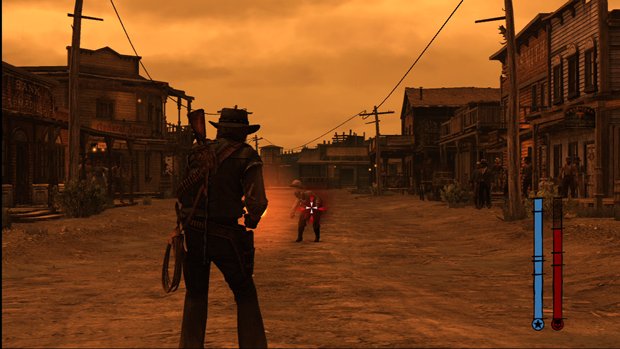A videogame history of bullet-time
Let's rake through the past of the most enduring of gimmicks. In slow-motion
2008 - Fallout 3

Bullet-time had lost its halo by 2008, but its use in Fallout 3 showed that in the right hands (and with a new implementation) it could be dynamite. You can’t beat a little bit of the old ultra-violence, and the way VATS expressed itself was the slow-motion cherry on Fallout 3’s irradiated cake. From the muffled sounds bullets, missiles and lobbed tin cans made as they flew through the air, all the way to the incredibly over-the-top decapitations and flying eyeballs, it was a satisfying spectacle. We expected it to unnecessarily slow the game down, but several thousand flying limbs later we’re still entertained.
2009 - Wolfenstein, WET, Wanted, FEAR 2: Project Origin

Above: Wolfenstein (2009)
In recent years bullet-time has become less and less of a main feature in gaming and become more of a side-salad. 2009 was the year that proved the sensation you only get in real life when you’re about to be hit by a bus a) isn’t leaving gaming and b) is now largely attached to games that feel a bit old.
Wolfenstein’s use of slo-mo was ho-hum and dated, WET was hung by its own repetitive slow-motion petard, and Wanted had bullet-spiraling moments of semi-joy but no one played it. As for FEAR 2, even we couldn’t help but admit that the game was good but the series needed new ideas, and quick. The lack of love for bullet-time in FEAR 3 marketing shows that Warner Bros. feels the same.
2010 – Read Dead Redemption
Sign up to the GamesRadar+ Newsletter
Weekly digests, tales from the communities you love, and more

Red Dead redemption is smart in that it doesn’t use slo-mo as a central gimmick. It’s just one more feature in an endless list of features. A couple of notable details about Red Dead’s idea of bullet-time: it gets upgraded as the game progresses, providing you with more and more precision of your shots, allowing you to pick out specific body parts and targets in what order you want before firing a shot. It also has its own meter, which isn’t particularly noteworthy, except that you can refill the meter in the middle of combat by scarfing some chewing tobacco. Way to promote mouth cancer, Red Dead!
2010 - Singularity

Singularity lets you snipe heads in slow-motion, and also has exploding barrels and a gravity gun. It’s a great shooter, but also a collation of every over-used FPS mechanic in the genre’s history. FPS developers: new balls please.
The future
When you look at recent and forthcoming shooters you realize that bullet-time is getting sequestered into different weapons and set-pieces rather than as a hook to hang a game upon. The allure of slow-motion gunplay is far less of a sales prompt in this day and age, and it’s no mistake that the games being released with it loud, proud and up-front are those that have been in development for an eon. Hollywood has moved away slightly from slow-motion action too, concentrating more on precision gunplay and the high adrenaline close-up body slams used by Bourne and neo-Bond.
As ever, perhaps not sadly in this case, games will follow Hollywood’s suit. We are at the point at which slow-motion bullet-play is uncool. Then again, no one is going to stop it from actually being slightly fun anytime soon. It’ll never truly go away, and we’ll never stop feeling a secret degree of satisfaction when we pop a few heads under its influence. There are only three constants in our lives: death, taxes and bullet-time.
Bullet-time quiz bonanza answers
Jade Empire: Focus Time
FEAR: Reflex Time
Painkiller: Haste
John Woo’s Stranglehold: Tequila Time
Doom 3: Resurrection of Evil: HellTime
Mirror’s Edge: Reaction Time
Call of Juarez: Concentration Mode
TimeShift: Slow Time
Wolfenstein: Mire
Killing Floor: Zed Time
Singularity: Temporal Dilation
Dark Messiah of Might and Magic: Adrenalin
Aug 31, 2010


Ear-shredding mishaps that'll make you wish you were Beethoven

Alan Wake got it right. Others? Not so much...


